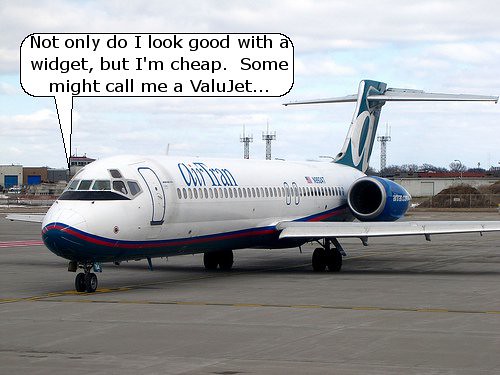One of the more interesting panels in Phoenix last week was the one that focused on fleet strategy. There’s always a ton of discussion about buying airplanes, and each airline has a different philosophy. On the panel, there were representatives from Air China, Delta, Hawaiian, and Southwest from the airline side. The CEO of Airbus Americas Barry Eccleston was also there.
Today, I want to focus on the the three US airlines there and their different strategies. It’s interesting that all may include the Boeing 717 in one way or another.
Delta the Opportunist
I was most interested in hearing from Delta’s VP of Fleet Strategy and Transactions Nathaniel Pieper. You might remember my post addressing why Delta had bought current generation 737-900ERs instead of waiting for next generation airplanes. Certainly Delta’s fleet strategy has differed from other legacy airlines.
I was particularly interested in the rumor broken by Holly Hegeman at PlaneBusiness that Delta would be acquiring the AirTran 717 fleet from Southwest. We didn’t get any details on that in this panel, but after hearing Nathaniel speak, it seems clear to me that the 717 would work quite nicely for Delta considering its strategy.
Nathaniel described Delta’s fleet strategy as one of opportunism. “We have every fleet type known to man.” That’s because Delta will go into the secondary market and buy airplanes if it makes sense. The MD-90 is a perfect example of that. Delta has been acquiring every MD-90 that’s on the market because they’re cheap to acquire and they’re good airplanes that can fly many of Delta’s medium haul missions.
Nathaniel wasn’t afraid to judge others, noting that you “won’t see us enter into a commitment for 460 firm aircraft with 500 options. We’d rather play the game a bit more conservatively, be in the game a bit more frequently and take smaller bites instead of one big chunk.” Hmm, I wonder why he picked that “460” number. Oh right, that coincidentally matches a certain recent order from American. Heh.
What about airplanes even smaller than the 717? The news is not good. To the surprise of nobody, Nathaniel explained that the “economics of the [50 seat RJ] is very challenging right now.” As if that wasn’t clear enough, he confirmed that Delta would like to shrink that fleet “substantially lower.” What would replace those airplanes? Either fewer flights on bigger jets or some markets might lose service all together.
Hawaiian Loves Its Fleet
Moving over to airlines that actually operate the 717 today, how does Hawaiian feel about the airplane? Peter Ingram, EVP and Chief Commercial Officer for the airline has nothing but love. “For the unique flying we do of 100 to 200 mile hops in the islands, the 717 is very good…. We like the 717 fleet and expect to be in it for this decade at least.”
The more interesting fleet for Hawaiian is that of the bigger jets. In the last two decades, Hawaiian has gone from the L1011 to the DC-10, then to the 767 and now to the A330-200. Why the A330? The airplane apparently has “great economics” to the west coast while at the same time giving more range to reach more places in Asia. Since that’s where Hawaiian has been expanding, this makes a great deal of sense.
Southwest, the Simple Airline
Let’s go from an airline that loves its 717s to one that wants to see them gone yesterday. Did Southwest tip its hat about the fate of the 717 at the airline? No, but the way Brian Hirsham, SVP of Technical Operations spoke, it sounded like the writing is on the wall to me.
Brian explained that the Southwest fleet strategy has two parts. The first part is simplicity. “We realize tremendous synergies by operating a simple fleet.” The 717 hurts that simplicity argument, of course.
The second piece? Flexibility. “We have the ability to flex up and down in terms of fleet size.” Southwest will be retiring 120 737-300/500 “classic” aircraft over the next couple years and replacing them with current generation 737-700/800 instead. But if demand rises, Southwest can simply keep those classic 737s flying longer. And yes, that could happen if, say, Southwest decided to drop an entire fleet type.
In the end, everyone seemed pretty confident with their strategies, and that’s no surprise. A good fleet strategy is key to running an airline. Sometimes, what works for one airline might not for another. And that’s why I’m keeping a close eye on those AirTran 717s…
[Photo via Flickr user redlegsfan21/CCSA 2.0]

